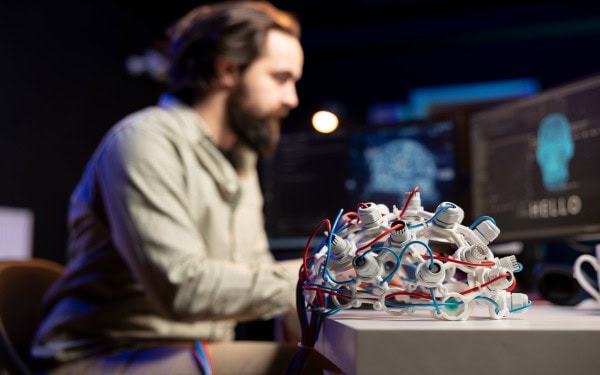Neuroplasticity, Advanced robotic systems are revolutionizing the field of physical rehabilitation, offering innovative approaches to help patients recover motor function after accidents or neurological diseases. This article explores current robot-based therapy systems and their advantages in the recovery process.
The Evolution of Robotic Rehabilitation
The integration of advanced technology with traditional rehabilitation techniques has led to the development of robot-assisted therapy systems. These innovative devices offer precise, repeatable, and customizable treatment options for patients recovering from various conditions affecting movement and mobility. Robot-assisted therapy systems come in various forms, each designed to address specific rehabilitation needs:
- Exoskeletons: Wearable devices that support and guide limb movements
- End-effector systems: Robots that interact with the patient’s limbs at specific points
- Treadmill-based systems: Devices integrated with treadmills for gait training
- Upper limb rehabilitation robots: Systems designed for arm and hand therapy
These systems can be used for a wide range of conditions, including stroke recovery, spinal cord injuries, and neurodegenerative diseases like Parkinson’s disease, but also neurodevelopmental disorders such as ADHD or Autism spectrum disorder. Modern robot-assisted therapy devices typically incorporate several key technologies, including sensors to measure patient movements and forces, actuators to provide assistance or resistance, control systems to adapt the therapy based on patient performance. They also include user interfaces for therapists to program and monitor treatment sessions. Many systems also integrate virtual reality components to enhance patient engagement.
The use of robotic systems in rehabilitation offers several benefits over traditional therapy methods, contributing to their growing adoption in clinical settings. Robot-assisted therapy can deliver highly precise and consistent movements, ensuring that patients receive the exact therapy prescribed by their healthcare providers. This level of accuracy is particularly beneficial for repetitive exercises, which are crucial for motor learning and neural plasticity. The ability to maintain consistent, high-quality movements throughout a therapy session, even as the patient fatigues, is a significant advantage of robotic systems. This consistency can help reinforce correct movement patterns and potentially accelerate the rehabilitation process.
One of the significant advantages of robot-assisted therapy is the ability to collect detailed data on patient performance. These systems can measure a wide range of parameters, including:
- Range of motion
- Force applied
- Movement speed and accuracy
- Number of repetitions completed
- Symmetry of movement (particularly important in gait training)
This data allows therapists to track progress objectively and adjust treatment plans accordingly, leading to more personalized and effective rehabilitation strategies. The ability to provide patients with concrete, measurable feedback on their progress can also serve as a powerful motivational tool. Therefore, robotic systems can support patients through a higher number of repetitions and longer therapy sessions than traditional methods. This increased intensity can potentially accelerate recovery by promoting greater neuroplasticity and motor learning. For example, in gait training, a robot-assisted therapy system can help a patient complete hundreds of steps in a single session, far more than would be possible with manual assistance from a therapist. This high volume of practice is crucial for reinforcing neural pathways and improving functional outcomes.
Many robot-assisted therapy systems incorporate gamification elements and virtual reality interfaces. These features can make rehabilitation sessions more engaging and enjoyable for patients, potentially improving adherence to treatment plans and overall outcomes. Virtual environments can simulate real-world tasks and scenarios, allowing patients to practice functional movements in a controlled, safe setting. This can help bridge the gap between clinical therapy and real-world application of skills, potentially improving the transfer of gains made in rehabilitation to daily life activities.
Robot-assisted interventions have shown particular promise in the recovery of patients with neurological conditions, where regaining motor function is often a primary goal.
Stroke is one of the leading causes of long-term disability, often resulting in impaired motor function. Robotic therapy has demonstrated effectiveness in helping stroke survivors regain mobility and independence. Studies have shown that robotic gait training can improve walking speed and endurance in stroke patients, while upper limb robots can enhance arm and hand function. The ability of robotic systems to provide partial assistance allows patients to actively participate in movements they might not otherwise be able to complete. This active participation is crucial for motor learning and can help prevent learned non-use of affected limbs.
For patients with spinal cord injuries, robotic therapy offers the opportunity for intensive, task-specific training that may not be possible with traditional methods. Robotic exoskeletons, in particular, have shown promise in helping patients with partial spinal cord injuries regain walking ability and improve overall mobility. These systems can provide the necessary support to allow patients to practice standing and walking movements, even when they lack the strength or control to do so independently. This early mobilization can have significant benefits for overall health and may help prevent secondary complications associated with prolonged immobility.
Patients with neurodegenerative diseases such as Parkinson’s or multiple sclerosis can also benefit from robotic interventions. These systems can provide targeted training to address specific symptoms, such as gait disturbances or tremors, potentially slowing the progression of motor decline. For example, robotic systems can be programmed to provide rhythmic cues or resistance training, which have been shown to improve gait parameters in patients with Parkinson’s disease. The consistent, repetitive nature of robotic therapy can help reinforce correct movement patterns and potentially compensate for the loss of internal cueing that occurs in some neurodegenerative conditions.
Challenges and Future Directions
While robot-assisted therapy offers numerous advantages, there are still challenges to address as the field continues to evolve.
One of the primary barriers to widespread adoption of robotic therapy is the high cost of equipment. Many healthcare facilities, especially in resource-limited settings, may find it challenging to invest in these advanced systems. However, as technology progresses and becomes more widely available, costs are expected to decrease. Efforts are being made to develop more affordable, portable robotic systems that could be used in outpatient clinics or even in patients’ homes. This could significantly increase access to this type of therapy and allow for more frequent, consistent treatment.
Finding the optimal balance between robotic and traditional hands-on therapy remains an area of ongoing research. While robots excel at providing repetitive, precise movements, the human touch and expertise of skilled therapists remain crucial for comprehensive recovery. Future approaches may involve hybrid models, where robotic systems are used to augment and enhance traditional techniques rather than replace them entirely. This could allow therapists to focus on more complex, individualized aspects of treatment while leveraging robotic systems for intensive, repetitive training.
The Future of Robotic Interventions in Movement Recovery
The field of robot-assisted therapy continues to evolve rapidly, with ongoing research exploring new applications and refining existing technologies. Dr. Christian Beste, a leading researcher in neurotechnology and recovery, emphasizes the importance of integrating robotic systems with our understanding of neuroplasticity. “These interventions offer unprecedented opportunities to harness the brain’s adaptive capabilities,” says Dr. Christian Beste. “By combining precise, intensive training with advanced neurofeedback systems, we can potentially optimize the recovery process and achieve better outcomes for patients.” Christian Beste and his team are currently investigating how robotic therapy can be combined with non-invasive brain stimulation techniques to enhance motor learning and recovery. This interdisciplinary approach, blending robotics, neuroscience, and clinical practice, represents the cutting edge of rehabilitation technology and holds great promise for the future of physical therapy.
As research progresses and technology advances, robotic interventions are poised to play an increasingly important role in movement recovery. By providing precise, intensive, and engaging therapy options, these systems have the potential to significantly improve outcomes for patients recovering from a wide range of conditions affecting motor function. While challenges remain, the continued development of this field offers hope for enhanced recovery and improved quality of life for many individuals undergoing physical rehabilitation.







